2013 Creative Writing International Travel Bursary Winner
Travel Destination: Bolivia
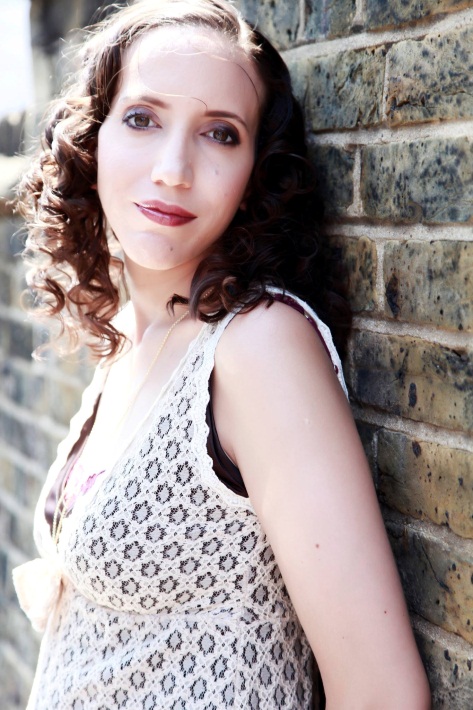
23/5/2014
Back to London
There’s torrential rain, Joey is barking very loudly and I am eating a baked potato with Rose Harissa Paste. This is London.
It is Thursday the 22nd May and I have been back since Saturday morning and I am now back on London hours. So far I have been to my lovely friend Beth’s beautiful baby’s christening and met up with friends.
What strikes me most about my relationship to Bolivia is that it has changed so much since my trip there. It is not only that I know my Bolivian family that much more but that I understand the Bolivian culture a lot more too. I know for instance the struggles they face and their dreams of their children studying abroad but more fundamentally what they think of the world outside Bolivia.
I was able to achieve quite a bit while in South America; I wrote 16 poems, that I am happy with so far, learnt how to cook some Bolivian food and got to see Samaipata, Tiahuanaco, Las Yungas and the Salt Plains. So all in all it was a successful trip and changed many aspects of myself, and my life.
I also learnt a great deal about what happened the day I fell 6/7 storeys (depending on how you count) from my aunt Nelly’s apartment and met one of the men who caught me in a blanket. I always imagined that I had fallen out of the living room window, but it turns out I had opened my bedroom window and hung out of its frame clinging on till I fell. I fell standing up. The porters who caught me never let me hit the ground. “It was my job” he tells me as I thank him repeatedly.
After, and maybe because of my fall, he married my nanny who had been grocery shopping and had left me with my gran. I like to think my fall brought them together, but they were dating already when it happened so who knows.
Here is a picture of me with him.

This is a giraffe. The giraffes in La Paz are rehabilitated drug users who help people cross the roads safely.

Before I went to the Salt Plains in Bolivia a part of me thought it would just be a whole bunch of sand and that it wouldn’t be worth it the daylong journey to get there.
I was wrong. It was so beautiful I don’t know how I could ever describe it, so here are some pictures.



Pink Flamingoes

I am so so happy in Bolivia.

Some Bolivian masks at a museum I visited in La Paz.


And a poem I wrote whilst there:
Daydreaming in La Paz
after Insomnia by Elizabeth Bishop
La Paz and my strange dreams
take a turn and become real.
Along the back of my tia’s apple tree
a wild rabbit.
I chase it, to find that I
am everywhere I’ve ever called home;
I am in East Dulwich buying a dress
on Lordship Lane, in Edinburgh,
in Texas writing love poems to a boy in my class
who doesn’t know I like him.
But I am also here in La Paz trying to breathe
through petrol fumes, waiting
as my cousin Patty fills her tank.
The rabbit knows this and chases me into its hole.
Walking is done like driving, in reverse here;
left equals right and right, left.
In this inverted, screwed up world
I try so hard to make real
it is you who loves me
and me who ignores your calls.
At home, Big Ben strikes midnight,
and you disappear just as you appeared.
Lastly a huge MEGA thank you to the Saltire Society and British Council Scotland as well as the lovely Robert Alan Jaimeson!
21/4/2014
Once my headaches and nausea have gone I start to enjoy being in La Paz and settle in quickly. This is perhaps because its mountains remind me of Edinburgh, or because I have the feeling that I am meant to be here at this precise moment.
View of La Paz
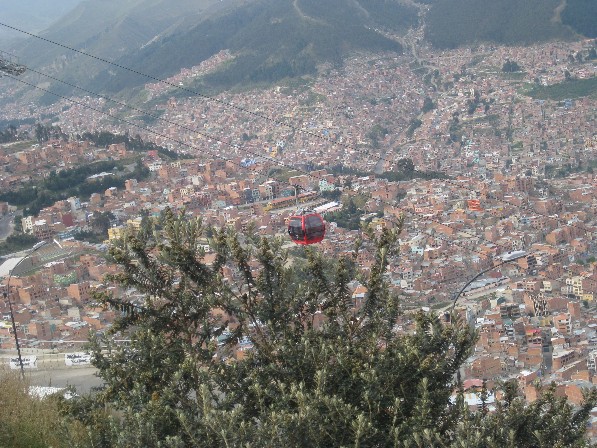
My first trip out of the city is to see the Tihuanaco ruins. It takes about 2 hours to get there by minibus. I travel alongside locals exploring their country and tourists from Australia and Germany. The roads there are mostly smooth and it is a comfortable journey.
Once there, we walk around the ruins, which are still being dug up and we are told that a whole city and civilization still lies at the bottom of a hill we climb.
The lack of money in Bolivia means that the work that is needed to be done there is slow, and that it is foreign countries that lead the exploration of Tihuanaco and not Bolivia.
The highlight of the trip to Tihuanaco is seeing the huge Monolitos, which age and decay means that we cannot photograph. “They used to be in the city of La Paz” our tour guide tells us “where their faces and shoulders were shot off during fights in the street, so they were bought back to their home recently.” “Tihuanaco is one of the places that has been destroyed by every generation”.
One of the smaller monolitos
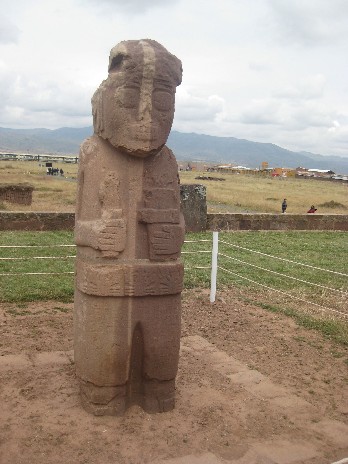
‘La Puerta del Sol’ (The Sun’s Door) was nearly taken to England by a lord but the war with Chile began so it was left behind. If it had been taken then it would be in the British Museum now.
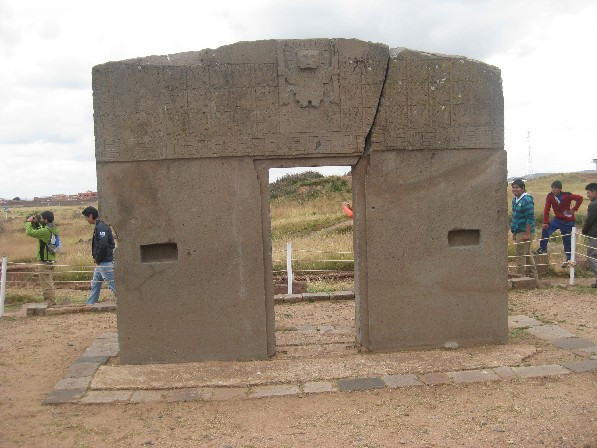
Faces of leaders carved into the walls. Some say that some of the faces are of aliens.
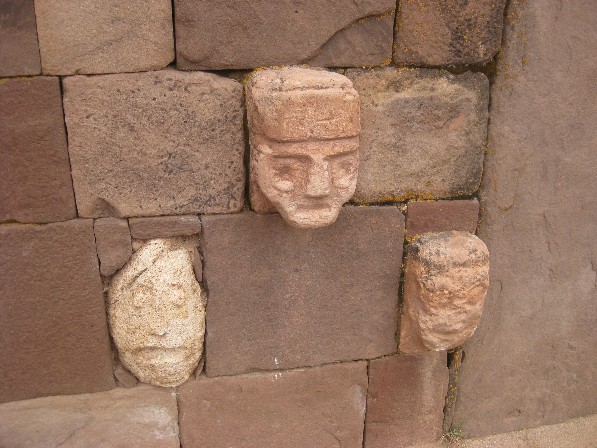
My next trip out of the city is to Coroico in The Yungas. There are two roads that go there; the old one called ‘the death road’, so called because of the number of deaths by those who use it, and the new one. I travel there using the new road.
You can still use the old route I am told and tourists like cycling along it just to say they have done it, but people generally use the new route now. I go there during the Easter weekend so the roads are packed and it takes longer to secure transport there. We pass mountains covered by snow so the journey is a cold one. It pours down with rain the whole journey there and once we arrive so we are wet once we arrive at our hotel.
I join a group of tourists and travel with them to an animal sanctuary where we see different types of wild monkey roaming around alongside parrots and turtles. We are told to not look into the monkey’s eyes as they will assume a friendship and jump onto us and not to laugh at them showing our teeth as this means we want to fight with them. One of the monkeys still manages to jump and hug one of our group but she is relaxed and happy so nothing bad happens.
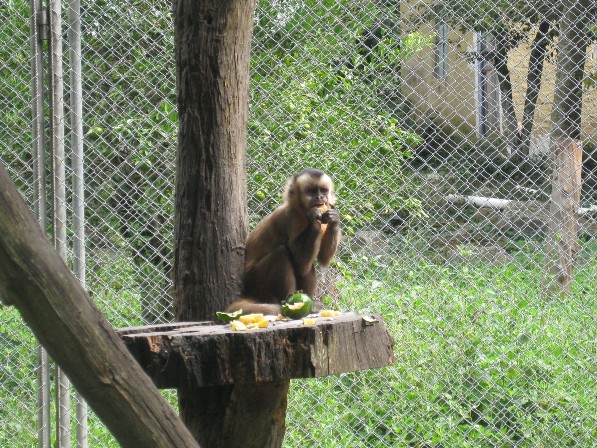
Our next trip is to the waterfalls, which are stunning to look at, but it is too cold to jump in. We return to La Paz the next day. There are no tickets left for any of the minivans so we go by minibus.
11/4/2014
Arriving in La Paz
I arrive in La Paz at night, after waiting hours in the airport after a mix up with my plane ticket. The sandwiches I buy at the airport smell of vinegar so I don’t eat them.
The view from the plane is nothing short of stunning. From the plane you can see golden lights that merge into chains that look like necklaces.
The rain that starts as I leave Santa Cruz follows me to La Paz and that night I fall asleep listening to it pour down.
I go to La Paz expecting cold weather only to be greeted by the sun the first morning I am here. Dressed in jeans and a jumper I bake in the heat.
La Paz is so high (the airport is roughly 4,058m above sea level) that there are certain things you have to do before you come and after you arrive. I take Sorojchi Pills and drink coca tea before I leave Santa Cruz, to prevent altitude sickness. I drink coca tea again after arriving in La Paz. I stay with my cousin Patty who tells me she has oxygen just in case I get ill. This is not an unusual thing to own here as lots of people become very ill because of the altitude.
Other things you have to do when you arrive is; rest for the first day you are here, limit your liquid intake and eat light food.
Patty tells me that a few years ago her son Jose Pablo became very ill when coming to La Paz from Santa Cruz. His heart had to work so hard it hurt, so his lungs worked overtime to help it. His lungs slowly filling with water as he threw up blood. He could have drowned. He was admitted to hospital.
He nearly died completing a journey he had done a hundred times before. Why? Because he didn’t rest enough when he got here.
So the next day is one of rest and going everywhere by car and bus. The bus we take is called a minibus and is basically a van-sized bus that you have to crouch down to get around in. I whack my head climbing in. There are bigger buses here now called Puma Katari, the first bus run by the state(which has wifi) but there is only one route for now, so people rely on Minibuses (small vans), Trufis ( A car version of the minbus) and Radio Taxis (a taxi), all of which are privately owned.
You can’t just stick out your hand out in a street and get into a taxi. “In Santa Cruz they will just kill you but here they kidnap you” Patty tells me, “the best way to get kidnapped is to get into the wrong taxi” she adds.
Patty lives in a three-storey apartment with her family. She has chosen to live in a small apartment for safety reasons. The day before I arrive there is an earthquake in Chile that was felt in La Paz. Patty tells me that the apartments with 40 plus floors waved from side to side here. Everyone was in the streets waiting. It wasn’t safe to be inside them. “We didn’t feel a thing” she says. Adding that there are only two buildings in La Paz that are built to survive earthquakes; the Central Bank of Bolivia and the Bolivian central post office(the Central offices of communications are a part of this.)
Before I leave La Paz I meet two poets called Paura and Gary. They tell me that there is no money for poetry magazines here or for poetry in general. Paura worked as a journalist at El Deber until they started downsizing. “Now one person does the job four did before” she says.
You can tell that money is tight everywhere; the stray dogs on the streets, the selling of government nutritional supplements by pregnant women on benefits, the multitude of markets selling second hand good imported from abroad and the housing. On my second day in Santa Cruz I go to turn the shower off and an electric current passes through my body.
The weather in La Paz changes a lot. It is hot in the morning, mild with rain in the afternoon and cold at night. There are less dogs on the streets here and more people seem to keep them as pets than in Santa Cruz. Though I still see a few dogs wondering around looking for food.
El río Piraí (The Piraí river) in Santa Cruz where locals go to bathe
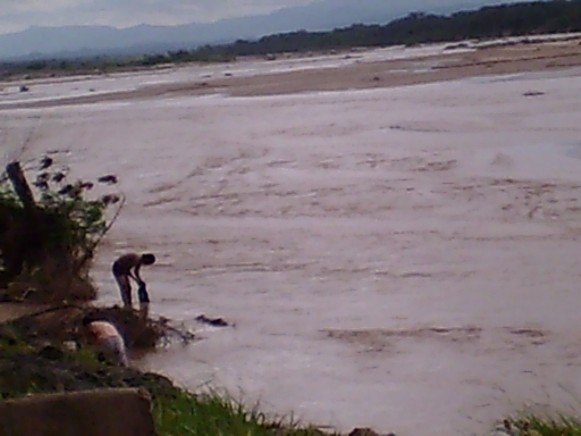
The view from where I am staying
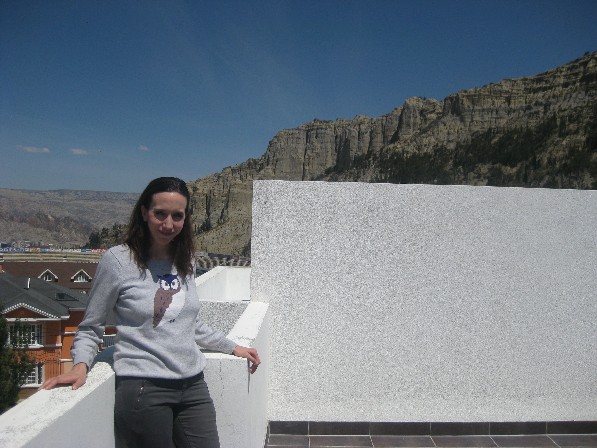
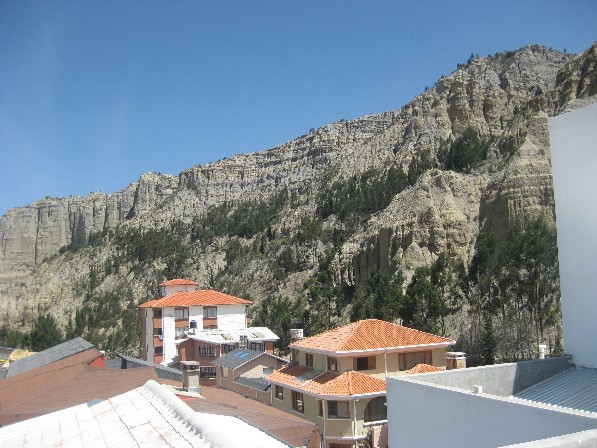
9/4/2014
The flight is long, perhaps too long. I am exhausted by the time we touch down in Santa Cruz.
Going through security is a journey in itself. I could have travelled to France from London in the time it takes me to get to my aunts on the other side. The airport is chaos; bags everywhere, people trying to join the queue from every angle. But the people are polite when they argue and agree to disagree on the subject of where the queue is.
The first thing that I notice about Santa Cruz is the heat. You cannot not notice it. It is unbearable and it forces me to take a nap as soon as I get to my aunt´s. It is so warm here I tan within a matter of days. People here walk around with hats permanently stuck to their heads, and umbrellas are used for anything but rain. I am told that before I arrived it rained for 14 continuous hours but there is no sign of rain while I am there.
Calls are made from internet cafes here because of the price of calls at home, so my first trips out are to the internet café; a tiny room with phone booths and computers whose keyboards have no letters on so it takes you ages to type if you are me and cannot touch type.
There is not a lot to Santa Cruz in the form of touristy things to see, so I travel for two and a half hours out of the city to some ruins in Samaipata. The road there is all dust and clay and anything but straight. When I get there though, the journey proves to have been worth it as the ruins are incredible and I take pictures as if the place were to be pulled down. It is a shortish walk around the ruins and the views are stunning.
The second thing I notice about Santa Cruz are the stray and wild dogs everywhere. I am a little weary of them at first but by the third day I am used to them and accept them as a part of Bolivia. I feel bad for the dogs and have to force myself not to feed them.
The markets here go on endlessly and are packed with shoppers. In the market we go to you can buy anything from knives; which are laid down on the table for anyone to pick up, to food, clothes and toys. I am a little uneasy when I see a cholita selling dogs as she picks them up carelessly as if they meant and were worth nothing. The attitude to animals here is different, dogs are meant for the outside and are fed scraps.
Some typical Bolivian food on sale at a food market in Santa Cruz
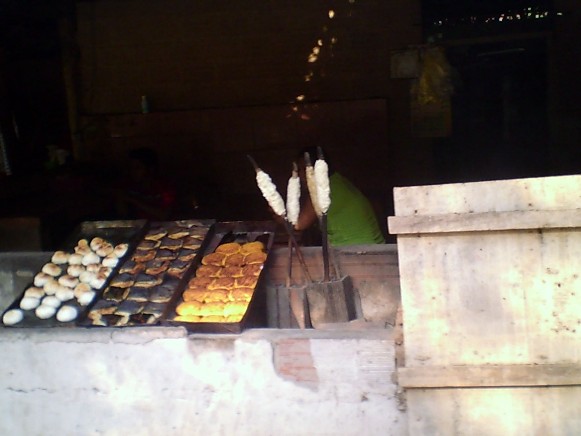
There is some really bad housing here where some of the indigenous people live but there are also some mansions that look like they belong to Brad and Angelina near the river.
Examples of indigenous housing in Santa Cruz
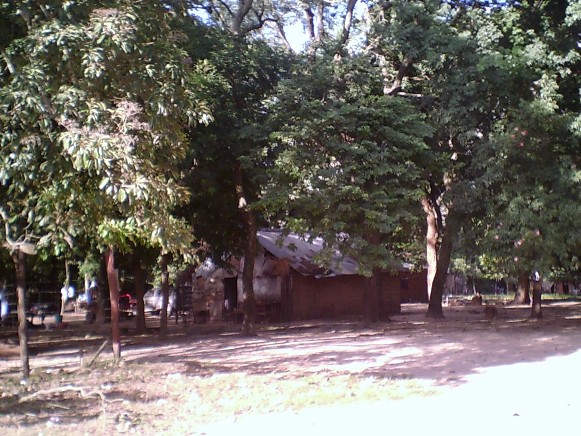
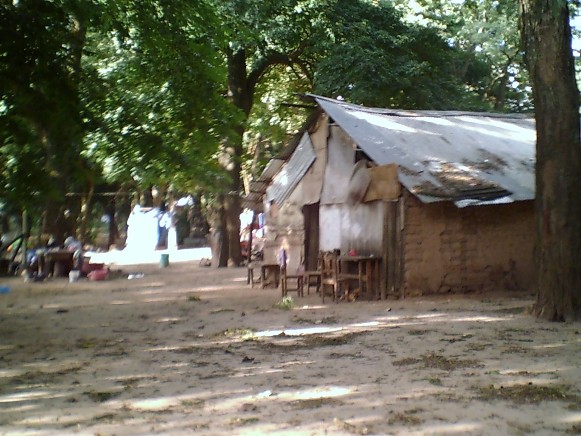
Las Casas en las colinas del Urubú: The houses in Urubú, a residential area where houses cost at least 2 million dollars each

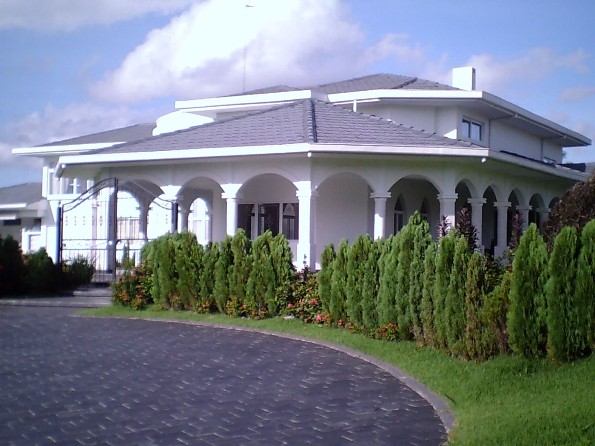
Santa Cruz is like that; everything at odds, people argue but politely and the maids once treated terribly are seen as friends almost, though they would never eat with the family even now.
As I get ready to leave for La Paz I sense that there must be more to the city than appears.
Samaipata
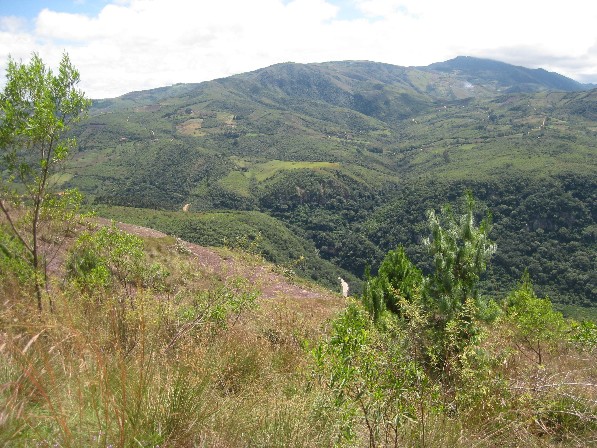

24/01/2014
As a three year old I fell out of my aunt’s seventh storey apartment while visiting my mother’s country Bolivia. As a consequence to this I spent several months in hospital, started primary school late and had to learn how to walk again.
I will use my Saltire award to visit Bolivia and travel around the country. I will arrive in Santa Cruz then I will travel to La Paz and then go onto Tarija after which I will go back to Santa Cruz.
I will primarily explore what happened the day I fell and interview and meet key people such as my blood donor as well as people who saw me fall and visited me in hospital after. I also hope to meet at least one of the people that caught me when I fell from a window and saved my life.
I will gather the information by recording interviews on a flip camera as well as an audio recording device and hope to tweet (@poetkat) and blog about my findings on my website. (http://katherinelockton.com)
I will then use all the information that I have gathered to explore how my fall changed my life and my relationship to the Bolivia and my Bolivian family through poetry.
I started writing about this pivotal event in my life during my Msc dissertation and explored that day and my fall by writing surreal poetry and hope to continue this to form my first pamphlet of poetry.
My pamphlet will explore how I fell, why I fell and how I have fallen since that day in other ways (in love, spiritually, on the sidewalk in New York etc). I hope to develop my quirky, surreal voice and write the basis of my first full collection of poems.
In addition to this, I will explore the indigenous people, that makes up over 70 per cent of Bolivia’s population and hope to explore my relationship with them in my poetry. I will compare my relationship to them now to the one I had with them as a child in Bolivia, when I was able to interact with them freely. I will do this by visiting key figures in my childhood such as my nanny.
I will conduct research and take notes and video footage of family members during my visit to Bolivia and use this during my Phd.
In addition to travelling and exploring the country, I hope to lead creative writing and literature workshops exploring Scottish and Latin American literature as part of the award in Universities in La Paz.